Ingredients
Method
Browning the Meats
- You'll want a nice deep skillet/Dutch oven with a lid to fit, or other heavy-bottomed pan for this. Cast iron is great. This is also a good use for stainless steel and its fondness for holding onto browned bits, which I am using here.
- I'm using turkey sausage here, so I decided to include some chopped bacon that we also had, mainly for the extra fat. (Plus, how bad could it be?) This is a completely optional step.Starting this off in about a tablespoon of sunflower oil, and frying over medium heat just until it starts rendering some of the grease.

- Where most people would start. Once there is enough fat in the pan to keep it from sticking--especially if you're using lean sausage--add in the sliced smoked sausage.

- NOTE: If at any point during these proceedings, it looks like your browned bits in the pan are wanting to start burning? Lower the heat a little, and add a splash of water if you need to. It's all good.We want plenty of Maillard goodness for rich flavor, but burning will spoil the party.
- Keep frying over medium heat, stirring and turning the sausage pieces occasionally until everything is well browned all over.

- Remove the browned meats into a bowl, and add the seasoned chicken to the pan.Spread the pieces out well, and adjust the heat a little as required to let them brown too, instead of flooding the pan with liquid.

- After a few minutes, flip those over and let them brown on the other side.When that's done, transfer into the bowl with the reserved sausage.

- This leaves us with this nice layer of gratin in the skillet. We want to hold onto all of that, for the flavor and color. Same with the fat, unless more than 2-3 tablespoons came out of your meat. (Spoon out any excess grease.)Don't worry, it will all come loose soon!
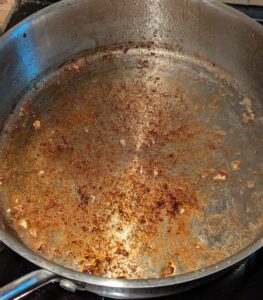
Cooking Down the Vegetables
- Add your Trinity, and stir around to coat with the grease.Turn down the heat a notch, sprinkle with salt to help the juices sweat out, and cover the pan. Let cook for around 10 minutes, stirring maybe once.
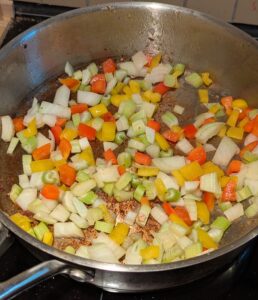
- Continue cooking down covered like this until everything is thoroughly softened. Stir occasionally, and add a splash of water to keep it from sticking if you need to.I didn't even take this down as far as some people like to, or as I would for some other dishes. But, this stage took probably 30-35 minutes--the vast majority of it hands-off time, when I could do other things between going back to stir and evaluate every so often.
- When the Trinity is nice and soft, add in the white parts of the green onions. Cook uncovered until they also soften--again, with the occasional stir and splash of water as needed. That'll probably take around 10 more minutes.
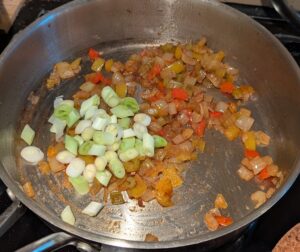
- When those are soft too, add the garlic and fry for a couple more minutes until you can really smell it. If you actually remember (unlike me!), add in the bay leaf at the same time.
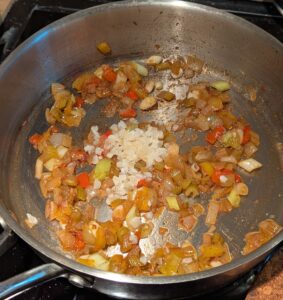
Pasta Time!
- Add in a small portion of the water, and stir it around to deglaze the pan. Scrape any stubborn browned bits loose to get dissolved.At this stage, I also put in the crumbled bouillon cube to dissolve.

- Stir in most of the rest of the water, and the other seasonings. I wasn't sure if it would need all the water, but this penne did.The main seasoning I'm using here is based on Chuck Taggart's Creole Seasoning Blend, from his (excellent!) classic Gumbo Pages site. It is purposely low on salt, so I can control that separately.
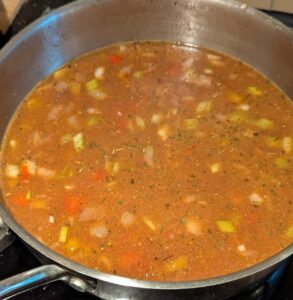
- If you're adding any cooked leftover meat, you can decide how likely it is to benefit from more cooking. If it'll be fine, add it in with the chicken and sausage. I was using up what was left of that roast pork tenderloin, and I was afraid that might get tough. So, it went in close to the end.
- Bring to a boil, and add in the cooked meat and dry pasta. Taste for seasoning. You'll want the broth a little saltier and more seasoned in general than for a soup, same as with rice dishes. The pasta will soak up a lot of that.This is about the liquid level we need, with one-pot pasta dishes in general. You'll want to poke the pasta down with a spoon, so that not too much is sticking up out of the broth. Something like penne will want to poke up more than smaller or flatter pasta shapes. It's fine.
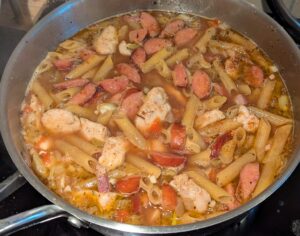
- Bring down to a simmer, cover again, and cook gently stirring every 5 minutes or so until it's done. You'll want to stir up from the bottom in sort of a folding motion, to make sure everything gets its fair turn fully down in the broth. (Again, more necessary with some shapes than others.)The pasta will take longer to simmer like this than the box's cooking time would suggest. That's normal and expected. This took about 20-25 minutes.
- When the pasta is nearly done to your taste, make any seasoning adjustments and stir in any extra meat or other ingredients which wouldn't take longer cooking. It should absorb most of the broth, and what's left should be thickened by the pasta starches. We're not aiming for a very saucy dish here.Let rest, covered, for 10 minutes. Scatter the green onion tops over it before serving.

- Dish it up, and enjoy!This is great served with just some salad on the side. Tonight we had more of that prepackaged oil-and-vinegar cabbage salad.

